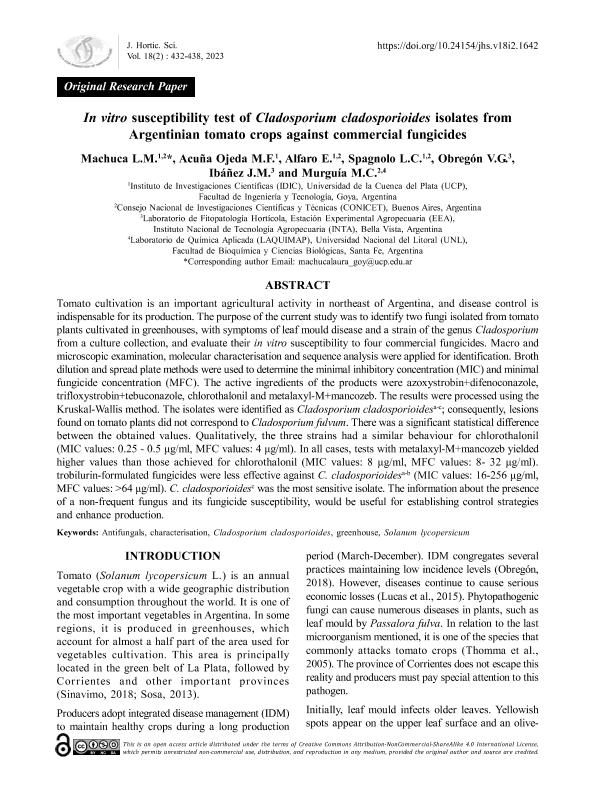Mostrar el registro sencillo del ítem
dc.contributor.author
Machuca, Laura Marcela

dc.contributor.author
Acuña Ojeda, Maria Florencia

dc.contributor.author
Alfaro, Esteban

dc.contributor.author
Spagnolo, Lorena Cecilia

dc.contributor.author
Obregon, Veronica Gabriela

dc.contributor.author
Ibañez, Julia Magali

dc.contributor.author
Murguia, Marcelo Cesar

dc.date.available
2024-04-05T11:00:19Z
dc.date.issued
2023-11
dc.identifier.citation
Machuca, Laura Marcela; Acuña Ojeda, Maria Florencia; Alfaro, Esteban; Spagnolo, Lorena Cecilia; Obregon, Veronica Gabriela; et al.; In vitro susceptibility test of Cladosporium cladosporioides isolates from Argentinian tomato crops against commercial fungicides; Society for Promotion of Horticulture; Journal of Horticultural Sciences; 18; 2; 11-2023; 432-438
dc.identifier.issn
0973-354X
dc.identifier.uri
http://hdl.handle.net/11336/232040
dc.description.abstract
Tomato cultivation is an important agricultural activity in northeast of Argentina, and disease control is indispensable for its production. The purpose of the current study was to identify two fungi isolated from tomato plants cultivated in greenhouses, with symptoms of leaf mould disease and a strain of the genus Cladosporium from a culture collection, and evaluate their in vitro susceptibility to four commercial fungicides. Macro and microscopic examination, molecular characterisation and sequence analysis were applied for identification. Broth dilution and spread plate methods were used to determine the minimal inhibitory concentration (MIC) and minimal fungicide concentration (MFC). The active ingredients of the products were azoxystrobin+difenoconazole, trifloxystrobin+tebuconazole, chlorothalonil and metalaxyl-M+mancozeb. The results were processed using the Kruskal-Wallis method. The isolates were identified as Cladosporium cladosporioidesa-c; consequently, lesions found on tomato plants did not correspond to Cladosporium fulvum. There was a significant statistical difference between the obtained values. Qualitatively, the three strains had a similar behaviour for chlorothalonil (MIC values: 0.25 - 0.5 μg/ml, MFC values: 4 μg/ml). In all cases, tests with metalaxyl-M+mancozeb yielded higher values than those achieved for chlorothalonil (MIC values: 8 μg/ml, MFC values: 8- 32 μg/ml). trobilurin-formulated fungicides were less effective against C. cladosporioidesa-b (MIC values: 16-256 μg/ml, MFC values: >64 μg/ml). C. cladosporioidesc was the most sensitive isolate. The information about the presence of a non-frequent fungus and its fungicide susceptibility, would be useful for establishing control strategies and enhance production.
dc.format
application/pdf
dc.language.iso
eng
dc.publisher
Society for Promotion of Horticulture
dc.rights
info:eu-repo/semantics/openAccess
dc.rights.uri
https://creativecommons.org/licenses/by-nc-sa/2.5/ar/
dc.subject
Antifungals
dc.subject
characterisation
dc.subject
Cladosporium cladosporioides
dc.subject
greenhouse
dc.subject
Solanum lycopersicum
dc.subject.classification
Biología Celular, Microbiología

dc.subject.classification
Ciencias Biológicas

dc.subject.classification
CIENCIAS NATURALES Y EXACTAS

dc.title
In vitro susceptibility test of Cladosporium cladosporioides isolates from Argentinian tomato crops against commercial fungicides
dc.type
info:eu-repo/semantics/article
dc.type
info:ar-repo/semantics/artículo
dc.type
info:eu-repo/semantics/publishedVersion
dc.date.updated
2024-03-26T15:25:22Z
dc.journal.volume
18
dc.journal.number
2
dc.journal.pagination
432-438
dc.journal.pais
India

dc.journal.ciudad
Bengaluru
dc.description.fil
Fil: Machuca, Laura Marcela. Universidad de la Cuenca del Plata. Secretaria de Politicas del Conocimiento. Instituto de Investigaciones Científicas (sede Goya); Argentina. Consejo Nacional de Investigaciones Científicas y Técnicas; Argentina
dc.description.fil
Fil: Acuña Ojeda, Maria Florencia. Universidad de la Cuenca del Plata. Secretaria de Politicas del Conocimiento. Instituto de Investigaciones Científicas (sede Goya); Argentina. Consejo Nacional de Investigaciones Científicas y Técnicas; Argentina
dc.description.fil
Fil: Alfaro, Esteban. Consejo Nacional de Investigaciones Científicas y Técnicas; Argentina. Universidad de la Cuenca del Plata. Secretaria de Politicas del Conocimiento. Instituto de Investigaciones Científicas (sede Goya); Argentina
dc.description.fil
Fil: Spagnolo, Lorena Cecilia. Instituto Nacional de Tecnologia Agropecuaria. Centro Regional Corrientes. Estacion Experimental Agropecuaria Bella Vista. Agencia de Extension Rural Goya.; Argentina. Consejo Nacional de Investigaciones Científicas y Técnicas; Argentina
dc.description.fil
Fil: Obregon, Veronica Gabriela. Universidad de la Cuenca del Plata. Secretaria de Politicas del Conocimiento. Instituto de Investigaciones Científicas (sede Goya); Argentina
dc.description.fil
Fil: Ibañez, Julia Magali. Instituto Nacional de Tecnologia Agropecuaria. Centro Regional Corrientes. Estacion Experimental Agropecuaria Bella Vista. Agencia de Extension Rural Goya.; Argentina
dc.description.fil
Fil: Murguia, Marcelo Cesar. Universidad Nacional del Litoral. Facultad de Bioquimica y Ciencias Biologicas. Laboratorio de Química Aplicada.; Argentina. Consejo Nacional de Investigaciones Científicas y Técnicas. Centro Científico Tecnológico Conicet - Santa Fe; Argentina
dc.journal.title
Journal of Horticultural Sciences
dc.relation.alternativeid
info:eu-repo/semantics/altIdentifier/url/https://jhs.iihr.res.in/index.php/jhs/article/view/1642
dc.relation.alternativeid
info:eu-repo/semantics/altIdentifier/doi/https://doi.org/10.24154/jhs.v18i2.1642
Archivos asociados
